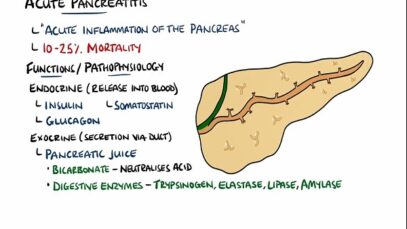Abdomen33 Videos



Biliary colic (gallbladder attack) – causes, symptoms, diagnosis, treatment, pathology
Approach to the management of gallstones Most individuals with gallstones are asymptomatic throughout their life and gallstones are found incidentally. The approach to the management of patients with gallstones depends upon the patient’s symptoms, imaging test findings, and whether complications are present. Gallstone complications include acute cholecystitis, cholangitis, gallstone pancreatitis, gallstone ileus, and Mirizzi syndrome. […]
Acute Pancreatitis
Management of acute pancreatitis Acute pancreatitis is an acute inflammatory process of the pancreas. Acute pancreatitis can be divided into two broad categories: edematous, interstitial acute pancreatitis and necrotizing acute pancreatitis. Mild acute pancreatitis is characterized by the absence of organ failure and local or systemic complications. Moderately severe acute pancreatitis is characterized by no […]
Acute Pancreatitis – Causes, Signs Symptoms, Pathophysiology, Diagnosis
Clinical features The majority of patients with acute pancreatitis have acute onset of severe upper abdominal pain. Patients may have associated nausea and vomiting. On physical examination, patients have abdominal tenderness to palpation. Patients with severe acute pancreatitis may have fever, tachypnea, tachycardia, hypoxemia, and hypotension. Laboratory findings Early in the course of acute pancreatitis, […]










